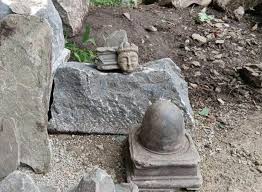 Image Source: Instagram
Image Source: Instagram
In a development that has stirred excitement among historians and religious communities alike, a team of local labourers in Jammu and Kashmir's Anantnag district uncovered a remarkable cache of ancient Hindu idols during a spring restoration project. The discovery was made at Karkoot Nag in the Salia area of Aishmuqam, located in south Kashmir, according to officials and local eyewitnesses.
Discovery During Routine Restoration
The excavation was part of ongoing revival and restoration work at the sacred spring of Karkoot Nag, an area already renowned for its religious significance among Kashmiri Pandits and the local Hindu community. Public Works Department (PWD) workers, engaged in clearing and renovating the spring, stumbled onto a collection of stone idols, many bearing exquisitely carved representations of Hindu deities.
Among the findings were at least 11 Shivlings, the symbolic representation of Lord Shiva, further deepening the site’s cultural resonance. Observers noted that these artifacts appeared carefully preserved beneath layers of earth and silt, raising speculation about their origins and the possible existence of an ancient temple in the area.
Official and Community Reactions
Soon after the discovery, the Jammu and Kashmir Department of Archives, Archaeology and Museums was notified. Experts visited the site, recorded the findings, and have since prepared to transfer the idols to Srinagar, where they will undergo scientific testing to ascertain their precise age and the nature of the stone used.
Officials stated that, "We will shift the artifacts to the SPS Museum, where departmental scholars and researchers will study them in detail." The department also aims to conduct radiometric dating and compositional analysis as part of the wider effort to document the region's heritage.
The news has triggered a swell of emotional response among local Hindus, particularly Kashmiri Pandits, who recall Karkoot Nag’s deep significance in oral tradition and historical records. One such member commented, "There has been an impact of the Karkoota dynasty in this area, so there is a probability that a temple might have been there or someone might have kept these idols for preservation."
Community leaders and residents have appealed to the government to ensure proper protection and religious reinstallation of the Shivlings. "We have heard there used to be a temple here. We appeal that a new temple be constructed and these Shivlings enshrined in it," said a local devotee.
Archaeological & Cultural Context
The discovery is believed to be closely linked to the region’s storied past, with the Karkoota dynasty (7th-9th centuries CE) frequently cited as a period of flourishing Hindu temple construction and religious activity in Kashmir. Karkoot Nag itself has long been a pilgrimage centre, and the newly found artifacts revalidate the belief that it was once home to a thriving temple complex.
This find echoes several recent discoveries of Hindu idols in Jammu and Kashmir, as the region’s complicated history continues to be unveiled through archaeological efforts and serendipitous finds.
Next Steps
The idols are en route to the SPS Museum in Srinagar for comprehensive testing and preservation. Archaeologists hope that detailed material analysis will date the artifacts, shedding light on their historical context and contributing to ongoing discussions about Kashmir's layered religious and cultural history.
Meanwhile, locals have requested round-the-clock protection of the site, as well as broader government support for religious tourism and infrastructure to honor the discovery.
This incident stands as a poignant reminder of Kashmir’s pluralistic, syncretic identity and the shared heritage of its communities—an identity many hope will continue to endure as more of the region’s past comes to light.
Relevant Sources: NDTV
Advertisement
Advertisement




